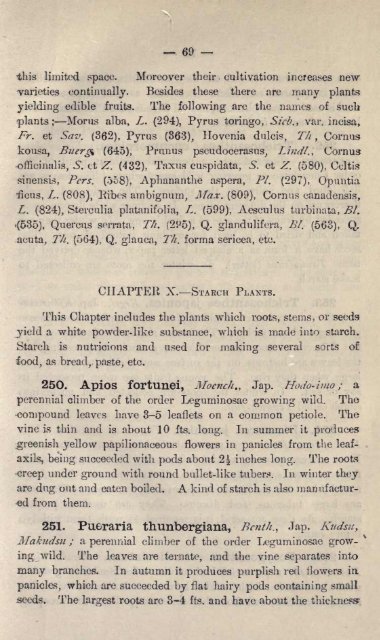Untitled - Library
Untitled - Library
Untitled - Library
You also want an ePaper? Increase the reach of your titles
YUMPU automatically turns print PDFs into web optimized ePapers that Google loves.
69<br />
-this limited space. Moreover their cultivation increases newvarieties<br />
continually. Besides these there are many plants<br />
yielding edible fruits. The following are the names of such<br />
plants; Morus alba, L. (294), Pyrus toringo, Sicb. t var. incisa,<br />
Fr. et Sav. (362), Pyrus (363), llovenia duleis, T/i , Cornus<br />
kousa, Bnergt (645), Primus pseudocerasus, Limit., Cornus<br />
officinalis, 5. et Z. (432), Tnxus cuspidata, 5. et Z. (580), Ccltis<br />
sinensis, Pcrs, (558), Aphananthe aspera, PI. (297), Opuntia<br />
ficns, L. (808), Kibes ambignum, Max. (809), Cornus canadensis,<br />
L. (824), Sterculia platanifolia, L. (599), Aesculus turbinata, Bl.<br />
(535), Quercus serrata, T/i. (2P5), Q. glandulifera, Bl. (563), Q.<br />
.acuta, TJi. (564), Q. glauca, 77i. forma sericea, etc.<br />
CHAPTER X.<br />
STARCH PLANTS.<br />
This Chapter includes the plants<br />
which roots, stems, or seeds<br />
yield a white powder-like substance, which is made into starch.<br />
Starch is nutricions and used for making several sorts of<br />
food, as bread, paste, etc.<br />
250. Apios fortune!, Moench., Jap. Hodo-imo ; a<br />
perennial climber of the order Leguminosae growing wild. The<br />
-compound leaves have 3-5 leaflets on a common petiole.<br />
The<br />
vine is thin and is about 10 fts. long. In summer it<br />
produces<br />
greenish yellow papilionaceous flowers in panicles from the leafaxils,<br />
being succeeded with pods about 2J inches long. The roots<br />
creep under ground with round bullet-like tubers. In winter they<br />
are dug out and eaten boiled. A kind of starch is also manufactured<br />
from them.<br />
251. Pucraria thunbergiana, Bcnth., Jap. Kudsu,<br />
]\Iakiidsu ; a perennial climber of the order Leguminosae growing<br />
wild. The leaves are ternate, and the vine separates into<br />
many branches. In autumn it produces purplish red flowers in<br />
panicles, which are succeeded by flat hairy pods containing small<br />
seeds. The largest roots are 3-4 fts. and have about the thickness-
















